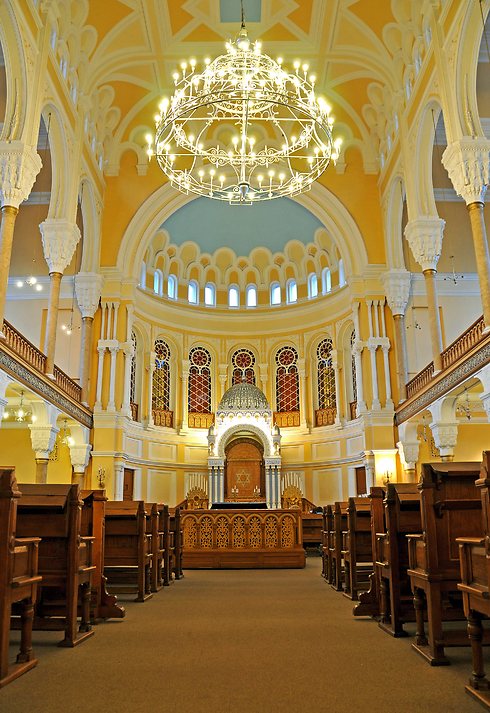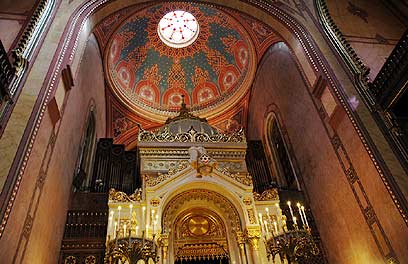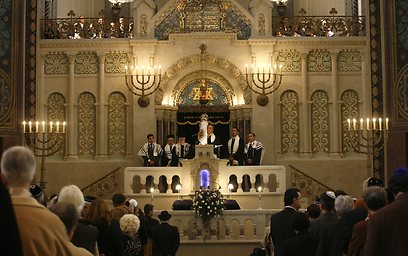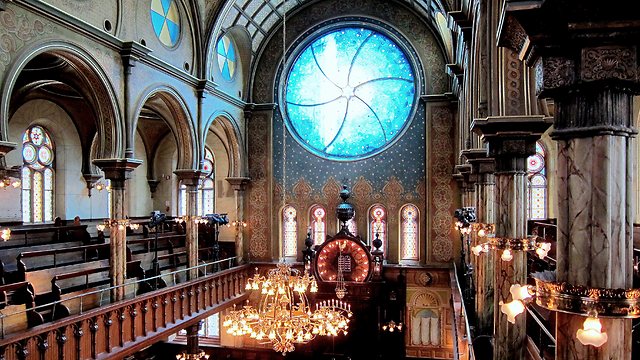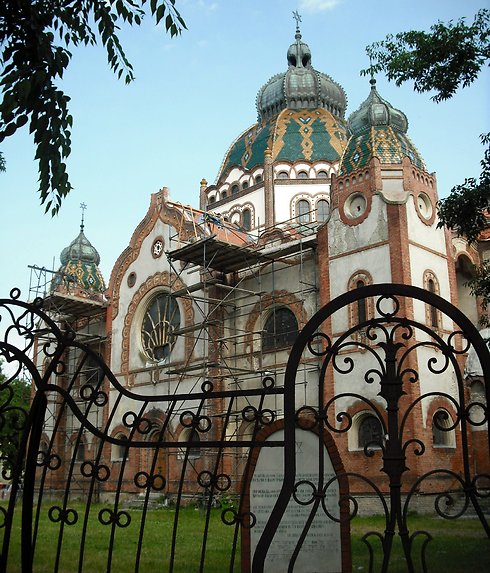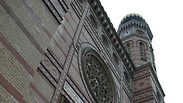
Yom Kippur special: The world's most beautiful synagogues
Despite the very modest demands of the Halacha for the design of Jewish houses of prayer, extremely impressive buildings have been erected around the world over the years. Here's just a peek into eight of these magnificent synagogues.
The Shulchan Aruch code of Jewish Law suggests having 12 windows partly facing Jerusalem, with the sky reflected through them, so that the worshippers can direct their hearts as they look at the sky. But apart from these instructions, the synagogue may be round or triangular, symmetric or asymmetric, as the architect pleases. It can also be made of wood, stone, iron or clay, and as long as there are 10 men present for a quorum - a proper prayer can take place.
Despite the very modest demands, extremely impressive buildings have been erected around the world over the years in places with thriving Jewish communities, which sought to demonstrate their presence through an impressive Jewish center, both in terms of its external architecture and the ornaments, chandeliers and furniture within it.
Here are several examples of centuries-old buildings, which are still considered some of the most beautiful synagogues in the world, and still serve - even as the Jewish community around them dwindles - as museums of the Jewish culture which used to thrive there.
Grand Choral Synagogue of St. Petersburg, Russia
The Grand Choral is the second largest synagogue in Europe. It was built between 1880 and 1888 after Tsar Alexander II cancelled some of the restrictions on Jews' residence in St. Petersburg and allowed Jews who served in the army, academics, senior merchants and technicians to live in the city and in other big cities.
The construction of the synagogue, which served the entire community in the capital of Tsarist Russia, took eight years. Famous Russian architect Vladimir Vasilievich Stasov supervised the design, which drew its inspiration from Berlin's New Synagogue, Arabesque motifs and Byzantine elements.
In 1999, Edmond Safra's family donated $5 million for the synagogue's renovation, and it is considered today one of the city's architectural pearls.
The Great Synagogue of Budapest, Hungary
The Dohány Street Synagogue is the largest in Europe and the second largest in the world, and can seat up to 3,000 worshippers. It was built between 1854 and 1859 at the heart of a neighborhood in which Theodore Herzl's house of birth stood.
The building is filled with Jewish symbols, mainly Stars of David which appear both in the stones and on the vitrage windows. The roof is topped by the Tables of the Covenant with the Ten Commandments engraved on them. The Bible verse "Then have them make a sanctuary for me, and I will dwell among them" (Exodus 25:8) appears at the front of the building facing the main street.
Upon the rise of Nazism, anti-Semitism in Hungary grew, and during World War II the synagogue was used as a stable and as the German army's radio communication base.
The Jewish community in Hungary has grown significantly smaller over the years, due to the immigration to Israel and the assimilation process, but the Great Synagogue of Budapest remains one of the most famous tourist attractions in the city. It is part of a complex which includes a museum on the history of the city's Jews, a Jewish cemetery and a memorial site for the 564,500 Hungarian Jews who were murdered in the Holocaust.
The New Synagogue of Berlin, Germany
The Neue Synagoge was built between 1859 and 1866 as the Jewish community's center of religious life and culture in Berlin. Because of the Arab elements in its design, and its resemblance to the Alahambra Palace in Granada, Spain, it was considered one of the most important buildings in Berlin in the second half of the 19th century.
The original building - with its golden dome and the main hall which seated up to 3,000 people - was torched during the Kristallnacht pogrom in 1938, although it was not completely burned. It sustained a lot of damage in the Allies' bombings during World War II and was demolished in 1958.
The synagogue's reconstruction work began only after the Berlin Wall was torn down, and in May 1995 it resumed its role as a Jewish cultural center, although it did not restore the glory of the 19th century.
The Sofia Synagogue, Bulgaria
The synagogue in Bulgaria's capital is the third largest synagogue in Europe. It is 31 meters high and can seat 1,300 worshippers in its main prayer hall. It was opened for Bulgaria's Sephardic community in a festive ceremony in September 1909, in the presence of Tsar Ferdinand I of Bulgaria, after nine years of construction.
The architectural style is Moorish with Arab elements, inspired by the Leopoldstädter Tempel in Vienna. The interior features many columns of Carrara marble, Venetian mosaics and a chandelier in the middle of the hall, which weighs 1.7 tons and is considered the biggest in the Balkans. The rumor said that the gold covering the chandelier came from the biblical Land of Israel.
Today the synagogue houses the Jewish Museum of History, which includes the Jewish communities in Bulgaria before and after the Holocaust.
Eldridge Street Synagogue, New York City
This was the first synagogue built in the United States by Jews from Eastern Europe. The building was designed by brothers Peter and Francis William Herter. When it opened in New York's Lower East Side in 1887, the media would stop praising its beauty, the high ceiling, the stained-glass rose windows, the magnificent copper designs and the handmade wall paintings.
For 50 years, the place served as a meeting point for the new immigrants arriving at the new world. There, they received a hot meal, information on odd jobs, apartments or any other need raised by the community. Over time, the community dwindled and the place was deserted by the end of the 20th century.
In 1996, the Eldridge Street Synagogue was designated a National Historic Landmark, and in December 2007, after 20 years of renovation that cost $20 million, it reopened to the public.
Jerusalem Synagogue in Prague, Czech Republic
At the end of the 19th century, during the reconstruction of Prague's Jewish Quarter, the "Society for the Construction of a New Temple" purchased an old house on Jerusalem Street as a site for a new synagogue that would serve the community. The construction work began in 1905, and the synagogue was dedicated during the holiday of Simchat Torah in 1906.It was designed in Moorish Revival form with Art Nouveau decoration. The entrance features a large Muslim arch and a large window with a Star of David at its center. The Bible verse "This is the gateway to the Lord – the righteous shall enter through it" (Psalm 118:20) appears above the arch. The main hall has seven arches on pillars supporting the building, and the women's gallery features vitrage windows and many copper chandeliers.
During World War II, the building was used as a storeroom, and as a result it did not sustain too much damage. In 2003, a parchment scroll was found in the synagogue, signed by the people involved in its construction with the following text: "May this temple survive many centuries and testify, even in the distant future, to the devout souls of its founders. May it fully serve its purpose for all time: to bring together worshippers in a place where they can uplift their souls to the Creator. May the Lord give! Done in Prague, on the 16th of September of 1906."
The synagogue still serves Prague's Jewish community and features a permanent exhibit which surveys the history of the Czech Jewry in the years after World War II.
Subotica Synagogue, Serbia
The Jakab and Komor Square Synagogue in Subotica was built in 1902 during the administration of the Kingdom of Hungary (part of Austria-Hungary). Hungarian architects Marcell Komor and Dezső Jakab were responsible for the design, and it is considered to this very day one of the finest surviving pieces of religious architecture in the art nouveau style, with its concrete and steel construction, mixed with ornaments from the popular Hungarian culture.
Its main dome is surrounded by smaller domes on four corners, and the interior design features golden wall decorations, wall paintings and stained-glass windows.
During the synagogue's construction, Subotica had a thriving Jewish community of some 3,000 members, which was almost completely annihilated during World War II. But although there are not enough worshippers left in the area, the building itself remains intact and has preserved its important role in the city's history. When there was no Jewish community left in the area, the building was used by the Subotica National Theater.
The Great Synagogue of Florence, Italy
Since the destruction of the Jewish neighborhood in Florence in 1848, the community members had sought to build a central synagogue which would serve all of the city's Jews. But the plans were only realized 30 years later, thank to a large donation from the president's community, David Levi, who left his estate and property for the construction of a synagogue which would be "worthy of Florence's beauty."
The synagogue was built in a style which was particularly popular those days, a combination of Moorish and Byzantine architecture. The synagogue's roof has a central dome raised on pendentives is reminiscent of the Hagia Sophia. The corner towers are topped with horseshoe-arched towers themselves topped with onion domes in the Moorish Revival style.
The synagogue is lit by 16 windows from above, and additional light comes from large windows on the eastern side of the building. The eastern part of the roof features half a dome which symbolizes the direction of the prayer.
The synagogue is located at the center of a public garden with exotic plants, and a magnificent Moorish style gate, creating an atmosphere of oriental splendor. The garden includes memorial stones, including one featuring the names of the Jews of Florence who were murdered in the Holocaust, a monument for the Jews of Florence who were killed during World War I while serving in the Italian army, and a memorial for three Florence Jews who were killed in Israel while fighting the War of Independence. Arie Avisar, who did a lot to restore the community after World War II, received his own monument.
The history of Florence's Jewish community is commemorated in an exhibition at the museum on the synagogue's first floor. The exhibition is divided into two parts: One features the history of Florence's Jews, and the other presents different items used for holy ceremonies and holidays.










